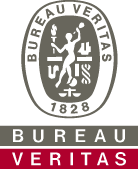Outstanding Equipment
-
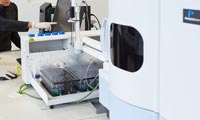
Perkin-Elmer ICP-OES Optima 7300 V Spectrometer
This piece of equipment helps to determine the content of wear metals, contamination and additives present in lubricating oils and greases.
Features
- Multi-element analysis in oil samples
- Rapid analysis
- Minimization of carbon deposit build-up
- Equipment maintenance is reduced to a minimumo
-
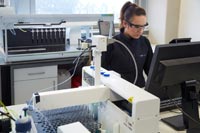
Perkin-Elmer JANUS® automated auto-dilution system
Equipment designed for preparing liquid samples with high capacity and performance.
Features
- Arm with 8 tips that dispense simultaneously from the sample vials to the test tubes for multi-tip processing
- Autonomy of up to 384 samples per batch
- Accurate pipetting and optimum performance
-
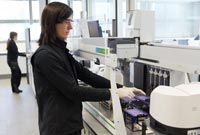
Perkin-Elmer FTIR OilExpress 4
Equipment that allows a large number of oil samples to be analysed per day, even highly viscous ones.
Features
- Greater sample performance. Up to 100 samples analysed per hour using OilExpress 4 DUO or up to 384 in a single batch unattended
- Significant savings as a result of the reduction in solvent residues, thanks to the smart cleaning system (up to 80% or more) in comparison with similar systems
- The results obtained comply with the most usual standards like ASTM or JOAP
-
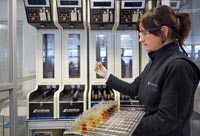
CANNON CAV® 2000 automatic viscometer
This equipment is designed to work unattended, as it has carousels of 50 samples per tube (100 per bath). The kinematic viscosity results are provided totally automatically, thus meeting the specifications of the ASTM D 445 standard. Transparent as well as dark or opaque liquids can be measured.
Features
- Modular construction of a single bath with two viscometers per bath
- Variable temperature selection system from 20°C to 100°C
- Viscosity range from 0.5 to 5000 cSt
- It meets the ASTM D 445 accuracy requirements
- The equipment measures 8 samples per hour with the standard tubes and up to 15 with fast run tubes
-
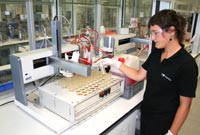
TAN/TBN T90 titrators with automatic GX-271 Mettler-Toledo sample handlers
Automatic titrator that allows two titrations to be carried out in parallel, independently of each other.
Features
- Automated GX-271 changers that allow up to 80 samples per changer in a single batch to be done
- Up to 160 titrations per batch can be carried out unattended
- Parallel titration
- Conditions in the functions of the methods
- Temporary memory for results
- Series sequence
-

LNF Q200 – ASP Spectro Particle Counter
An analytical tool that enables the counting of particles in lubricating oils to be carried out as well as the study of the morphology and distribution of wear and/or contamination particles present in the oil.
Features
- The morphological analysis is carried out automatically on the basis of an intelligent system of neural networks
- The equipment uses a camera to detect and determine the number of particles and their morphology
- No calibration is needed since verification with a check fluid is sufficient
- It removes the possible air particles and water bubbles present in the fluid from the result
- It can give the different ISO, NAS, NAVAIR, etc. classifications.
- It facilitates automatism and increases productivity as hundreds of daily samples can be handled unattended.
-

Metrohm 851 water content K.F. Coulometer
Equipment that determines the water content in oils in an optimum range of between 10 and 10000 ppm.
Features
- As the titration is carried out by means of an oven, a large quantity of potential contaminants are prevented from entering the titration cell.
- Its high degree of automatism allows it to work unattended.
-
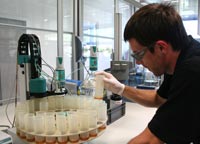
Metrohm 859 Thermometric Titrator
A piece of equipment that is used on samples in which a sufficiently large temperature change in the dissolution of the sample is produced during the reaction. It is particularly suited to titrations that are difficult to carry out using other techniques, above all in certain types of synthetic oils or with a complicated additive package.
Features
- Easy handling and conducting of the thermometric titration through the incorporation of intuitive titration software
- An alternative method to other analytical techniques in which titration is difficult or causes problems.
- Rapid results (in less than a minute)
- The sensor requires no calibration
- The sensor requires no maintenance
-
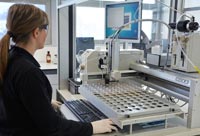
CiNRG Particle Counter
The CiNRG Particle Counter is a system for counting the particles in any type of oil: hydraulic, gear, lubrication, etc.
Features
- Autonomy enabling it to handle up to 100 samples per batch
- Sample consumption is very low, in the region of 10-15 ml
- It is not necessary to weigh or measure the volume of the sample because the equipment undertakes to carry out the dilution specified in the method
- It allows the sample to be automatically diluted if highly viscous samples are being analysed (>320 cSt)
- Calibration is in accordance with current standards (ISO 4406)
- Size range: 4 µm(c) to 70 µm(c) (6 channels of the following sizes: 4, 6, 10, 14, 21, 25, 38, 70 µm(c))
-

Jasco V-570 measurement of varnish potential (MPC)
With the help of the UV-Vis-NIR laboratory equipment it is possible to determine the varnish potential (MPC) of a broad range of oils.
Features
- The software allows the various CIE ΔE, a, b and L values to be obtained, is indicated in the recently published ASTM standard
-
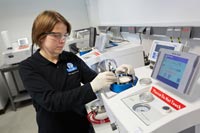
Mettler-Toledo HP-DSC 1
With the help of a high pressure Differential Scanning Calorimeter it is possible to determine the onset of the degradation of an oil. That way it is possible to assess the useful or remaining life of the oil.
Features
- Temperature scale: ambient temperature – 500/700⁰C
- Heating speed: 0.1-50 K/min
- Pressure range: 0-10 MPa
- Gas flow: Freely selectable; accurate control of purge gas flow and total pressure with an external controller
- Atmosphere: Measurements under different atmospheres: inert, oxidizing, reducing, reactive, etc.Atmosphere: Measurements under different atmospheres: inert, oxidizing, reducing, reactive, etc.
-
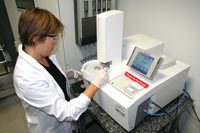
Mettler-Toledo TGA/DSC 1
With the help of thermogravimetry it is possible to evaluate how the change in mass of new as well as used oils takes place under controlled heating conditions.
Features
- It determines the level of carbon deposit present in the oil
- Its thermal and/or oxidation stability can be predicted even at high temperatures (800-1000⁰ C)
- It is possible to determine the content of volatile compounds, humidity, etc.
- It studies the behaviour of different oil formulations: whether they increase in weight or lose it due to decomposition, oxidation or dehydration
-
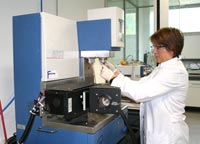
TA Instruments RFS3 rheometer
Rheometry helps to understand the rheological properties (viscoelasticity, shear rate, etc.) or behaviour of lubricant oils and greases according to pressure, temperature, shear rate, etc.
The ARES-RFS rheometer is configured either with the Peltier or Recirculating Bath temperature control option. Both environmental control systems can be easily exchanged if necessary. Due to the fact that the torque measurement is carried out separately, the ARES-RFS is capable of providing inertia-free dynamic measurements of low viscosity, structured fluids over a wide frequency range, independent of the material’s viscosity.
Features
- Software with menus (Orchestrator Software)
- Viscosity range: 10-3 to 104 Pa-s
- Stability range 10-3 to 102 rad/s
- Dynamic range 10-5 to 102 rad/s
- Torsional stress from 2×10-7-102 mN.m
-
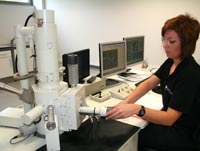
Oxford Instruments JEOL JSM-5600LV Scanning Electron Microscope (SEM)
The Scanning Electron Microscope (SEM) allows the observation and surface characterization of inorganic and organic materials to provide morphological information about the material analysed. On the basis of that, various types of signal are produced and are generated from the sample and used to examine many of its characteristics.
Features
- High resolution (~100 Å). The image resolution obtained by a scanning electron microscope is much higher than that which can be obtained using an optical microscope, because electrons (with a much lower wave length) are used instead of light to transform the image.
- Great depth of field that gives the images a 3D appearance.
- The conducting of chemical analyses on small areas: intermetallic phases, precipitates, contaminant particles, etc.
- Straightforward preparation of samples

